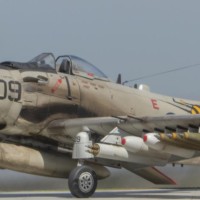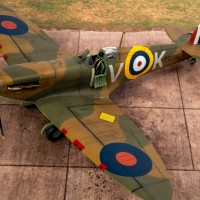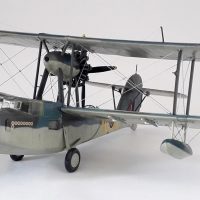Airfix's 48th Scale de Havilland Vampire F.3
According to BAE Systems, The success of the Gloster Meteor led to the De Havilland Aircraft Company being approached to design and build an airframe for the Halford H1 turbojet engine (later to become the DH Goblin). Initially designated DH99 (named the ‘Spider Crab'), it was an all-metal design which was hugely experimental in its unorthodox arrangement of twin rear booms mounted behind a molded, egg-shaped wood/aluminum fuselage and one single engine. Further modifications resulted in the design re-designated as the DH100 Vampire.
The prototype DH100 Vampire (LZ548/G) was first flown on 20th September 1943 at Hatfield by Geoffrey R de Havilland (son of the founder), 6 months after the Meteor, due to delayed by engine availability.
The first production DH Vampire (F.1) was produced by the English Electric Company at Warton due to the production pressures and a lack of capacity at Hatfield. Despite finally arriving after the end of the Second World War, the DH Vampire was eagerly awaited and became the second British jet fighter to see service with the RAF. It was also given the honor of leading the VE - Day fly-past over London. It was the first RAF aircraft to be able to exceed 500.
The main production version was to be the DH Vampire FB.5 fighter bomber (a modified DH Vampire F.3) and this variant was also be the basis for many of the export versions.
Separate night fighter and trainer models were produced as the DH113 Vampire NF and DH115 Vampire Trainer respectively.
A number of DH100 Vampires were also modified for shipboard use such as the De Havilland DH Sea Vampire and on 3rd December 1945, Captain Eric 'Winkle' Brown completed the first successful landing and take-off of a jet fighter from the Carrier HMS Ocean. Subsequently, it became the Royal Navy's first jet fighter.
The type was very successful in the export market, providing many air forces with their first experience of jet fighter operations and around 30 air forces were ultimately to operate the type. Some fifty DH100 Vampire F1, F2 and FB variants were purchased by the Royal Australian Air Force in 1946 and, although the majority were built with Goblin engines, the second aircraft was built with a Rolls-Royce Nene power-plant.
By the time production finally ended, 3,269 Vampires had been built in England and a further 1,067 built under license abroad. The DH Vampire remained as a front-line fighter for the RAF until 1953, after which it was retained only in the pilot training and refresher role.
Elsewhere, the aircraft had surprisingly longevity with large numbers still in service in several air forces in the 1980s. The Swiss Air Force was the last Vampire user, retiring their sizeable fleet of DH Vampire FB.6s and T.55s from active service as late as 1990 It was finally retired from RAF service in 1966, being replaced by the Hawker Hunter and Gloster Javelin.
DH Vampire F.3 version had a production run of two prototypes and 202 airframes. It featured revised tail surfaces of a more ‘De Havilland' shape; tailplane chord increased. Maximum weight increased to 11,970 lb. and flown 4 November 1946. 20 were exported to Norway and 86 aircraft sold to Canada.
During the build, I found that the engineering of this kit is very well thought-out. Most of the parts fell into place. I did have difficulty mating the upper and lower halves together and the intakes, but I eventually got there. My biggest problem was self-induced. I didn't add enough ballast and ended up packing the nose gear bay with more lead. I'm not sure that 17 grams is enough, so be sure to verify the balance.
Some unused parts hint at other variants to be released in the coming years.
A fuller description of the build can be found at https://modelingmadness.com/review/korean/gb/fighters/sumvam.htm










Nice looking RCAF Vampire build John
Thanks
Excellent build, John.
Thanks. I enjoy seeing your builds.
Looks wonderful in this RCAF scheme, John @jsummerford
Thanks for sharing the historical background of it.
Thanks. I enjoy researching the history of subjects.
There's already the FB.5/9 been released by Airfix. The Swedish Pilot Replicas model company has released a Vampire Trainer that is very nice.
This model is very nice, John. As you state, the kit is very well designed. I did mine with the flaps down and the speed brakes open.
Here is a link to a nice build of the Pilot replica model, and some fixes on the way https://www.ipmsstockholm.se/phpBB3/viewtopic.php?f=3&t=13266
Thanks for the link.
Thanks. I still feel unhappy about the tail sitting.
Very, very beautiful build, John @jsummerford. The nmf looks great! My kit was warped, unfortunately. Huge seam around the fuselage.
Thanks. I'm glad to read that someone else had problems with that seam. Now I know it's not just me.
Excellent build and ditto article, John!
Well done, John. Love the Canadian scheme
Thanks. I'm glad the the Canucks represented a vampire for their Vampire--and that it is an option in the kit.
Great build John, beautiful job. Sounds like an awesome kit. Great to see your MM post also.
I’m amazed just how small the Vampire is, and packs a mean punch.
Waterloo Warbirds in Ontario use this livery for their DH115 T55 Vampire, and it is (maybe was) available for flights to the public - only $3k Cdn 👀.
Thanks. When I was on staff at the Museum of Flight, they had one in pieces at the restoration facility. I was amazed to see the wooden portion of the fuselage. Next time I'm in Ontario, (OK. I've never been.) I'll have to visit the museum.
Beautiful model and an excellent, informative article, John @jsummerford! 👏
I'm glad you like the article.
Nice work on an early British jet.
Thanks. The kit provides a good result.
Great work and I like the Candian markings ...I did mine in British . IT is a nice little kit!
Wonder if they will do the T.11 in 1/48?
Steve
1 attached image. Click to enlarge.
Lovely! Yes. a T.11 would be fun to build too.
Good looking Vamp, and a very cool scheme - well done!
Thanks. I couldn't resist the scheme.
Nice Vampire, John. That is a nice kit. Like you I had some trouble closing the top and bottom fuselage halves cleanly but a little work with a sanding stick on the interior components made it work. C’mon, Airfix, Sea Venom next…….
We can only hope...